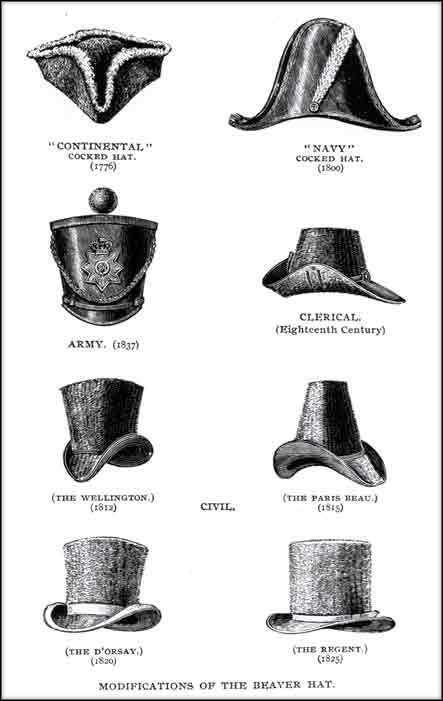
 Prized for
their warmth, luxurious texture, and the longevity of
fur as a
material, furs have
played a large role in clothing
people since the beginning of human history. For everyday
use or costume and decoration, furs have been used for the
production of outterware
such as coats and cape, garment and shoe lining, a
variety of head coverings, and ornamental trim and
trappings.
Prized for
their warmth, luxurious texture, and the longevity of
fur as a
material, furs have
played a large role in clothing
people since the beginning of human history. For everyday
use or costume and decoration, furs have been used for the
production of outterware
such as coats and cape, garment and shoe lining, a
variety of head coverings, and ornamental trim and
trappings.  removed, and felts (removing the fur from the pelt, and
processing it with heat and pressure to form
a piece of pliable material). Due to the strength
and malleable quality of felts, they were used extensively in hat
making. The physical structure of beaver fur predisposes it to
the felting process, making it a highly desirable fur for felt
production. (photo of beaver fur hat courtesy of www.chichensterinc.com/FurHats.htm)
removed, and felts (removing the fur from the pelt, and
processing it with heat and pressure to form
a piece of pliable material). Due to the strength
and malleable quality of felts, they were used extensively in hat
making. The physical structure of beaver fur predisposes it to
the felting process, making it a highly desirable fur for felt
production. (photo of beaver fur hat courtesy of www.chichensterinc.com/FurHats.htm) felts.
The careful guarding of
this trade secret helped to maintain the Russian monopoly.
(photo of felted beaver hat courtesy of www.pilgrimhall.org)
felts.
The careful guarding of
this trade secret helped to maintain the Russian monopoly.
(photo of felted beaver hat courtesy of www.pilgrimhall.org) Fortunately, although perhaps not for the American beaver,
the
depletion of European beaver populations coincided with the
establishment of European colonies in North
America.
England, France, and the Netherlands had all established
North American colonies by the early-to-mid 17th
century. Although beaver populations could be found
all over
North America, beaver in the northern parts of the
continent
contained the fuller coats that were more desirable in the fur
trade.
As a result, French Canada, British holdings in the Hudson Bay, and the
Dutch New Netherlands (later, the English colony of New York) played
key roles in establishing the North American fur trade.
Because there were no
physical differences between the north American beaver (Castor canadensis) and the European
beaver (Castor fiber), the
American beaver was an easy substitute for the
near-extinct European beaver. (image courtesy of www.iroquoisdemocracy.pdx.edu)
Fortunately, although perhaps not for the American beaver,
the
depletion of European beaver populations coincided with the
establishment of European colonies in North
America.
England, France, and the Netherlands had all established
North American colonies by the early-to-mid 17th
century. Although beaver populations could be found
all over
North America, beaver in the northern parts of the
continent
contained the fuller coats that were more desirable in the fur
trade.
As a result, French Canada, British holdings in the Hudson Bay, and the
Dutch New Netherlands (later, the English colony of New York) played
key roles in establishing the North American fur trade.
Because there were no
physical differences between the north American beaver (Castor canadensis) and the European
beaver (Castor fiber), the
American beaver was an easy substitute for the
near-extinct European beaver. (image courtesy of www.iroquoisdemocracy.pdx.edu) The
exchange of goods inhabited a realm that tied two cultures together
economically, symbolically and politically. An open market for
European goods in the colonies, and the supply of raw material from the
colonies to Europe, helped drive the colonial economy. The
introduction of steel tools and gun powder weaponry transformed
indigenous American society. The Europeans, on the other hand,
heavily relied upon their Native American neighbors for access to
American resources, such as the beaver. (image courtesy of www.lcmm.org/site/harbor/resource_pages/timeline/contact/exploration.htm)
The
exchange of goods inhabited a realm that tied two cultures together
economically, symbolically and politically. An open market for
European goods in the colonies, and the supply of raw material from the
colonies to Europe, helped drive the colonial economy. The
introduction of steel tools and gun powder weaponry transformed
indigenous American society. The Europeans, on the other hand,
heavily relied upon their Native American neighbors for access to
American resources, such as the beaver. (image courtesy of www.lcmm.org/site/harbor/resource_pages/timeline/contact/exploration.htm) shape,
and material all carried specific
meaning. In Ecclesiastical heraldry, for
example,
a red, wide-brimmed hat clearly indicated that its
wearer was a cardinal, and
interactions required a specific social protocol. In
seventeenth
century England, the shape and style of one's hat
reflected
political and religious affiliation. Due to the
expense of a
beaver hat, being able to purchase one made a visual statement
about
one's wealth and social status.
shape,
and material all carried specific
meaning. In Ecclesiastical heraldry, for
example,
a red, wide-brimmed hat clearly indicated that its
wearer was a cardinal, and
interactions required a specific social protocol. In
seventeenth
century England, the shape and style of one's hat
reflected
political and religious affiliation. Due to the
expense of a
beaver hat, being able to purchase one made a visual statement
about
one's wealth and social status.  In the seventeenth and eighteenth centuries, beaver hats
were produced
for sale domestically in the French and British markets, as
well as for
export. The French domestic market included
military and naval
contracts, as well as consumer products sold on the general
market. The majority of their exports were shipped to
French
colonies in the Caribbean, Italy, Portugal, Spain, and Spanish
South
America.[6]
Britain's exportation of beaver hats picked up in the
eighteenth
century, after the acquisition of much of the Hudson Bay
Territory of French
Canada following the War of Spanish succession In the
1720's, the
British exported to their own Caribbean colonies in Jamaica:
two dozen
beaver hats and one dozen half beaver hats); three dozen
half beavers
to Bilbao; three dozen beaver hats to Barbados; and three
dozen beaver
hats and three dozen felts to Calais. By the 1730's,
Britain "exported formerly by the dozens but now by the hundreds of
beaver and half beaver hats to the British West Indies."[7]
On the European continent, Britain was able to infiltrate the Iberian
market. From 1700 to 1750 the revenue from beaver hats shipped to
Spain and Portugal, and then on to their colonies, increased from
£44,000 to over £263,000.[8]
Of Britain's fur exports, 85% were comprised of beaver hats, 45%
of which were exchanged with Spain and Portugal for bullion.
Additional evidence regarding the sale of beaver hats in Europe
demonstrates greater English sales in Holland and Germany, with French
advantages in Switzerland, the Baltic, and smaller markets in Spain and
Italy.[9]
In the seventeenth and eighteenth centuries, beaver hats
were produced
for sale domestically in the French and British markets, as
well as for
export. The French domestic market included
military and naval
contracts, as well as consumer products sold on the general
market. The majority of their exports were shipped to
French
colonies in the Caribbean, Italy, Portugal, Spain, and Spanish
South
America.[6]
Britain's exportation of beaver hats picked up in the
eighteenth
century, after the acquisition of much of the Hudson Bay
Territory of French
Canada following the War of Spanish succession In the
1720's, the
British exported to their own Caribbean colonies in Jamaica:
two dozen
beaver hats and one dozen half beaver hats); three dozen
half beavers
to Bilbao; three dozen beaver hats to Barbados; and three
dozen beaver
hats and three dozen felts to Calais. By the 1730's,
Britain "exported formerly by the dozens but now by the hundreds of
beaver and half beaver hats to the British West Indies."[7]
On the European continent, Britain was able to infiltrate the Iberian
market. From 1700 to 1750 the revenue from beaver hats shipped to
Spain and Portugal, and then on to their colonies, increased from
£44,000 to over £263,000.[8]
Of Britain's fur exports, 85% were comprised of beaver hats, 45%
of which were exchanged with Spain and Portugal for bullion.
Additional evidence regarding the sale of beaver hats in Europe
demonstrates greater English sales in Holland and Germany, with French
advantages in Switzerland, the Baltic, and smaller markets in Spain and
Italy.[9]